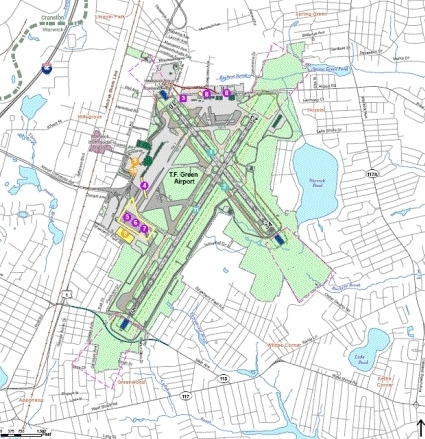
WARWICK – The Federal Aviation Administration gave its preliminary blessing on Tuesday to the Rhode Island Airport Corporation’s preferred plan for increasing capacity at T.F. Green Airport by extending the main runway southward and shifting its shorter crosswind runway.
RIAC’s plan calls for T.F. Green’s main northeast-southwest runway to be expanded with 1,534 feet of additional pavement and a 600-foot safety area. The long-sought additional capacity would allow nonstop flights from T.F. Green to California and Western Europe.
The plan also would require that a bend be put in Main Avenue around the extension, and that the intersection of Airport Road and Post Road be pushed north to Hasbrouck Avenue.
The plan would require the FAA to acquire 11 homes and 10 businesses, with the potential to take up to 201 more homes if the owners approve.
“This is the preferred alternative because it’s the least intrusive with regard to wetlands, the impact on the city, as well as cost and [the number of] home acquisitions,” Patti Goldstein, spokeswoman for RIAC, told Providence Business News today.
Officials estimate that the runway repairs and property acquisitions would cost about $170 million, with 75 percent of the cost picked up by the FAA and the rest covered by RIAC revenue. The total cost, including related private expansion efforts, is projected to top $400 million.
FAA officials will discuss the decision, which had been expected, at a public meeting with residents on June 3 at 6 p.m. at the Crowne Plaza Hotel Providence-Warwick.
Barring complications, FAA is expected to release its draft environmental impact statement on the plan early next year, with a final decision, known as a record of decision, made roughly a year from now.
Kevin Dillon, RIAC’s president and CEO, has said he hopes construction could be completed by 2013. Dillon took the top job at T.F. Green in January 2008, after nearly a decade at the helm of Manchester Boston Regional Airport, where he oversaw a $500 million expansion.
Warwick Mayor Scott Avedisian has expressed reservations about the plan, but also said the preferred alternative was better than other expansion proposals that have been floated previously.
Laurie White, president of the Greater Providence Chamber of Commerce, hailed the FAA’s decision. The chamber long has advocated expanding capacity at T.F. Green.
“Today’s announcement marks an important milestone in working to make T.F. Green Airport regionally competitive and a true engine of economic growth,” White said in a statement.
“In today’s challenging economy, it is more important than ever that we continue to develop and support the state’s transportation infrastructure that is so critically important to continued growth,” she said. “The result will be economic benefits that will yield an important payback for the entire community and state.”
The R.I. Airport Corporation (RIAC) is a quasi-public organization, based at T.F. Green Airport in Warwick, that oversees T.F. Green and the state’s five general aviation airports. Additional information is available at PVDAirport.com












A most important step forward. T. F. Green is an important economic engine for RI that needs to be competitive in the 21st century.
Let’s not forget other neighorhoods already affected by the noise and pollution–those which the airport will not be buying out or soundproofing. I am sure we will endure more sleepless nights due to those allegedly important late-night flights. How did we ever survive without them? Its just more bad news as far as I am concerned. Any financial benefit will certainly not be enjoyed by me, my neighborhood, my city or my state. Thanks for nothing, FAA.
The cost for all of this is a little steep and safety is compromised.
RIAC consistently borrows for expansions. With almost $300 million in bonds and loans currently on the books, RIAC’s debt service is more than half of its gross. Even if the FAA provides 75% of this $170 million expansion, RIAC will be very hard pressed to float a bond for the remainder. Note that there is another $200 million mentioned in the story. FAA will not fund that piece. Wnen all is said and done, RIAC would need to borrow an additional $238 million. No bond rating agency would ever approve that level of debt.
Another interesting note: Mr. Dillon talks about 600 foot safety areas. FAA standards call for 1,000 foot safety areas. By shoehorning this runway expansion into an area that takes ten or so houses, rather than about 200 houses that such an expansion would normally take, creates a safety issue that does not currently exist. Most crashes occur during landings, not takeoffs. The longer runway actually creates a safety problem because the all-important undershoot areas are comprimised. The current main runway is much safer than the proposed alternative according to FAA safety documents.